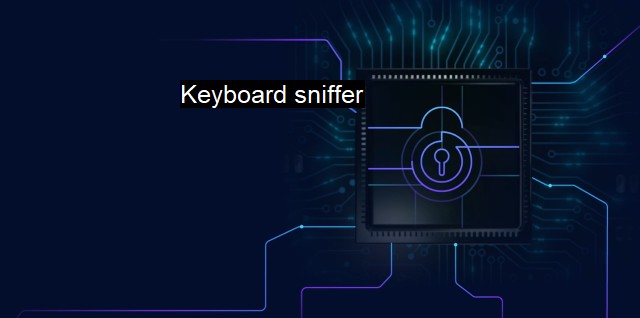What is Keyboard sniffer?
Protecting Your Digital Security: The Risks and Consequences of Keyboard Sniffers and Prevention Strategies
A keyboard sniffer, also referred to as a keylogger, is a type of surveillance technology used to monitor and record each keystroke made on a computer keyboard. This tool, steeped in the context of cybersecurity and anti-virus applications, can exist in both hardware and software forms. While it has legitimate uses, such as in troubleshooting, data, and systems analysis, law enforcement operations, or parental control, the keylogger has become associated more significantly with malicious applications, notably for cyber espionage, the stealing of sensitive information, and other cybercrimes.In the domain of cybersecurity, keyboard sniffers present a serious threat to information security. They function by tracking every keystroke and accordingly accumulating valuable data, which may consequently encompass confidential information such as login credentials, credit card numbers, personal emails, and other sensitive data. This data can be exploited for criminal activities like identity theft, unauthorized fund transfers, corporate espionage, and a host of other misuses.
Hardware-based keyloggers function through a physical device plugged between the computer's keyboard and the system unit. These keyboard sniffers store the recorded data within themselves, which can later be accessed by the attacker. In contrast, software-based keyloggers are malicious programs that reside in the system and operate in the background unnoticed by the user. They record keystrokes and typically send the data back to the attacker over the internet.
One defining trait of keyboard sniffers is their discreet operation - most of them operate silently without the knowledge of the computer user. Consequently, it becomes considerably challenging to detect their presence. They come in different varieties, including kernel/driver keyloggers, API-based keyloggers, memory-injecting keyloggers, form grabbing keyloggers, and packet-analyzing keyloggers. Each of these presents a different form of threat to the information systems and consequently needs a varied approach for effective detection and neutralization.
The threat posed by keyboard sniffers has underscored the importance of robust cybersecurity practices and inventive antivirus applications. Antivirus software utilizes a multitude of techniques to detect keyboard sniffers, such as signature-based detection, heuristic analysis, and behavior blocking. An effective antivirus identifies suspicious behavior or patterns, quarantines potential threats, and eliminates them before they can do any damage.
Behavior-based detection is becoming increasingly preferred due to the advanced nature of modern-day keyloggers. This method monitors the activity on the system and focuses on irregular, not just harmful actions. Similarly, machine learning and artificial intelligence are being leveraged to counteract the increasingly sophisticated methods employed by cybercriminals.
It’s also been recognized that safeguarding against keyboard sniffers extends beyond fundamental antivirus protection. Reactive measures include regularly changing passwords, monitoring bank accounts and credit reports for unauthorized activity, and being mindful of suspicious communications asking for sensitive information. Preemptive measures include education about the potential signs of compromise, double-checking sources of email and software downloads, and further securing laptops or mobile devices that may be targeted.
While keyboard sniffers are perceived as a significant threat in the cybersecurity domain, constant technological advancement in security measures is providing effective counterpoints. Combatting keyboard sniffer threats requires a blend of user awareness and literacy, constant system monitoring, and advanced protection strategies to ensure the security and privacy of data. As cyber threats like keyboard sniffers continue to evolve, so too must our approach to mitigate their impact, highlighting the actionable and dynamic nature of cybersecurity and the ever-important role of antivirus protection in this digital age.

Keyboard sniffer FAQs
What is a keyboard sniffer and how does it work?
A keyboard sniffer is a type of malicious software that records every keystroke made on a keyboard, including passwords and sensitive information. It works by intercepting and recording data from the keyboard driver, then transmitting that data to a remote server or storing it on the infected device.How can I protect myself from keyboard sniffers?
To protect yourself from keyboard sniffers, you should use antivirus software and keep it up-to-date. You should also avoid downloading and installing software from unknown sources, and be careful when entering sensitive information online. Using a virtual keyboard or a secure password manager can also help protect against keyboard sniffers.Can antivirus software detect and remove keyboard sniffers?
Yes, most antivirus software can detect and remove keyboard sniffers. However, some sophisticated keyboard sniffers may be able to evade detection by antivirus software, so it's important to keep your software up-to-date and use additional security measures to protect against them.Is it illegal to use a keyboard sniffer?
In most countries, using a keyboard sniffer to gain unauthorized access to someone else's data is illegal and can result in criminal charges. Even if the keyboard sniffer is used for legitimate purposes, such as monitoring employee computer activity, it is important to obtain consent from all parties involved and comply with applicable privacy laws.| | A | | | B | | | C | | | D | | | E | | | F | | | G | | | H | | | I | | | J | | | K | | | L | | | M | |
| | N | | | O | | | P | | | Q | | | R | | | S | | | T | | | U | | | V | | | W | | | X | | | Y | | | Z | |
| | 1 | | | 2 | | | 3 | | | 4 | | | 7 | | | 8 | | |||||||